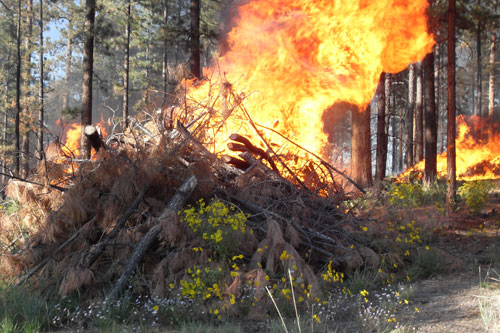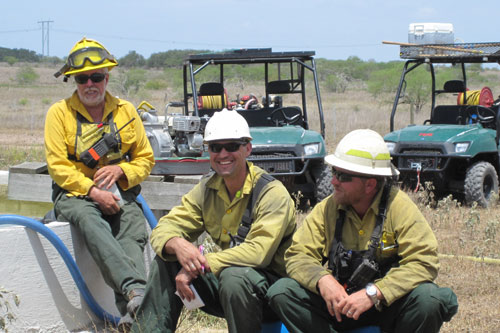
[Editor’s note: Jeremy Bailey is the Fire Learning Network Coordinator for The Nature Conservancy.]
Last week, deep in a ponderosa pine forest north of Santa Fe, New Mexico, a radio crackled to life. A Forest Service dispatcher was requesting the status of a lightning-caused wildfire throwing smoke above the mountains.
A short pause, and then perhaps an unexpected response from the lead forester in the area — “This is a beautiful fire.”
I heard the radio exchange because I was in the forest at the time leading a team of international volunteers — from Spain, Costa Rica, Argentina, Mexico and the U.S. — on the use of controlled burns to improve the health of forests for people, water and wildlife. As foresters, biologists and firefighters, the volunteers came together to exchange their respective fire knowledge and expertise. We also managed to “treat” more than 700 acres of forest with safe, controlled fire.
The forester’s radioed response reflected a true knowledge of America’s forests. For eons America’s forests and grasslands were shaped by the natural elements of water, weather and fire. Today our lands, water and wildlife still need fire to be healthy.

Over the last century, however, we interrupted this natural cycle by attempting to suppress all fires. Instead of widely spaced trees managed by low-intensity natural fires — which used to be the norm for many lowland forests — these areas became choked with thick, unhealthy brush. Without the thinning action of natural fires to create spacing, our forests became standing tinderboxes prone to the kind of unnatural megafires we are seeing today.
Of course, this modern “feast or famine” fire cycle is not only bad for forests, but it’s also dangerous for people.
As a 20-year professional fire worker who has witnessed homes lost to fire-and the men and women who put their lives at risk trying to protect these communities, I can understand the conflicting emotions that arise with wildfire. When lives are lost and homes destroyed by fire, how dare I (or anyone else) claim wildfire can be a good thing?
The answer, in short, is that there is good fire and bad fire.
What is good fire?
- Fire that restores health to a sick and dying forest… that is good, whether it be a naturally ignited wildfire or a controlled burn.
- A fire that burns excess vegetation and prevents megafires from consuming life and property… that too is good.
- Fire that protects our water, stimulates desired plants and protects habitat for insects and animals… that is good fire, and across the nation we need much more of it.
The science on fire and climate change is clear; if we don’t act boldly, we will lose large expanses of our precious forests in the Southwest. It is this knowledge that drives our work and our fire workshops, and I am confident the experience and co-training that occurred in Santa Fe at our fire workshop this fall can help restore these unique American forests and make our communities safer.
The Washington Post reports: U.S. runs out of funds to battle wildfires
[Top image: Prescribed fire. Image source: Mary Huffman. Second image: The author, Jeremy Bailey (middle), with his fire crew. Image source: Ray Guse]